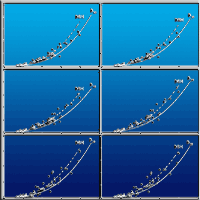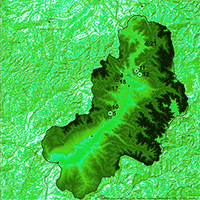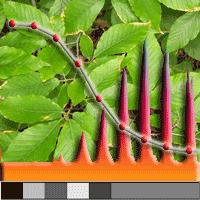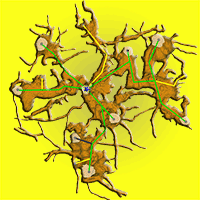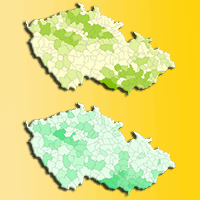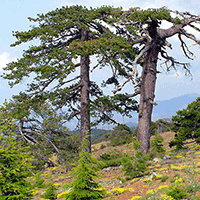
Effect of tree age on chemical compounds of ancient Anatolian black pine (Pinus nigra subsp. pallasiana) needles in Northwest Turkey
Nezahat Turfan (1), Mehtap Alay (1), Temel Sariyildiz (2)
iForest - Biogeosciences and Forestry, Volume 11, Issue 3, Pages 406-410 (2018)
doi: https://doi.org/10.3832/ifor2665-011
Published: May 15, 2018 - Copyright © 2018 SISEF
Technical Notes
Abstract
Plant primary and secondary metabolites are chemical compounds synthesized for essential functions, such as growth and development (primary metabolites), and specific functions, such as pollinator attraction or defense against herbivory (secondary metabolites). Their concentrations in plants are genetically determined, but are also affected by environmental factors. Among these factors, plant age has been reported to influence plant chemical compounds under similar environmental conditions. We aimed to investigate the chemical compounds of ancient Anatolian black pine (Pinus nigra subsp. pallasiana) needles from trees of different ages. Needles of over 500-, 200-, 100-, 50-, and 25-year-old black pine trees growing under similar environmental conditions were sampled and analyzed for photosynthetic pigments (chlorophyll a, chlorophyll b and carotenoids), proline, total soluble protein, glucose, sucrose, total soluble sugar, peroxidation level (MDA-malondialdehyde), hydrogen peroxide (H2O2) and antioxidants such as ascorbate peroxidase (APX), catalase (CAT) and superoxide dismutase (SOD) activities. Significant differences for chemical composition associated with age were found. In general, results showed that over 500-year-old Anatolian black pine had the highest proline, total soluble protein, H2O2, sucrose, total soluble carbohydrates, APX, CAT and SOD concentrations, whereas they had the lowest chlorophyll a, total chlorophyll, total carotenoid and glucose concentrations. However, 200-year-old trees had the highest glucose, but the lowest chlorophyll b, proline, H2O2 and total soluble carbohydrates. 50- and 25-year-old trees together showed the highest chlorophyll a and b, total chlorophyll, total carotenoid and MDA, but lowest total soluble protein and sucrose. In conclusion, these results provide valuable insight into the chemical composition of Anatolian black pine needles in relation to their age, and can be used for complementing studies on tree growth-defence relationships.
Keywords
Ancient Trees, Anatolian Black Pine, Chemical Composition, Turkey
Authors’ Info
Authors’ address
Mehtap Alay
Kastamonu University, Faculty of Science and Art, Department of Biology, 37100 Kastamonu (Turkey)
Bursa Technical University, Faculty of Forestry, Department of Forest Engineering, 16310 Bursa (Turkey)
Corresponding author
Paper Info
Citation
Turfan N, Alay M, Sariyildiz T (2018). Effect of tree age on chemical compounds of ancient Anatolian black pine (Pinus nigra subsp. pallasiana) needles in Northwest Turkey. iForest 11: 406-410. - doi: 10.3832/ifor2665-011
Academic Editor
Silvano Fares
Paper history
Received: Oct 25, 2017
Accepted: Jan 30, 2018
First online: May 15, 2018
Publication Date: Jun 30, 2018
Publication Time: 3.50 months
Copyright Information
© SISEF - The Italian Society of Silviculture and Forest Ecology 2018
Open Access
This article is distributed under the terms of the Creative Commons Attribution-Non Commercial 4.0 International (https://creativecommons.org/licenses/by-nc/4.0/), which permits unrestricted use, distribution, and reproduction in any medium, provided you give appropriate credit to the original author(s) and the source, provide a link to the Creative Commons license, and indicate if changes were made.
Web Metrics
Breakdown by View Type
Article Usage
Total Article Views: 49689
(from publication date up to now)
Breakdown by View Type
HTML Page Views: 41425
Abstract Page Views: 4356
PDF Downloads: 3024
Citation/Reference Downloads: 7
XML Downloads: 877
Web Metrics
Days since publication: 2768
Overall contacts: 49689
Avg. contacts per week: 125.66
Citation Metrics
Article Citations
Article citations are based on data periodically collected from the Clarivate Web of Science web site
(last update: Mar 2025)
Total number of cites (since 2018): 11
Average cites per year: 1.38
Publication Metrics
by Dimensions ©
Articles citing this article
List of the papers citing this article based on CrossRef Cited-by.
References
Ecological attributes and distribution of Anatolian black pine (Pinus nigra Arnold. subsp. pallasiana Lamb. Holmboe) in Turkey. Journal of Environmental Biology 33: 509-519.
Gscholar
Methoden der enzymatischen analyse [Methods of enzymatic analysis]. Akademie Verlag 1: 190-302. [in German]
Gscholar
Osmoregulatory role of proline in plants exposed to environmental stressed. In: “Handbook of Plant and Crop Stress”(Pessarakli M ed). Marcel Dekker, New York, USA, pp. 675-695.
Gscholar
Chemical analysis of food (8th edn). Churchill Livingstone, London and New York, pp. 5-63.
Gscholar
Experiments in plant physiology. Van Nostrand Reinhold Company, New York, USA, pp. 55-56.
Gscholar

